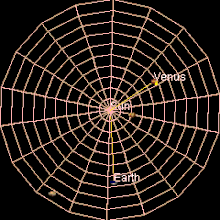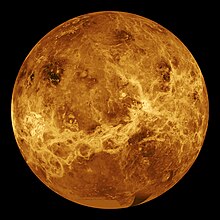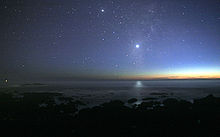Venus is classified as a terrestrial planet and is sometimes called Earth's "sister planet" owing to their similar size, gravity, and bulk composition (Venus is both the closest planet to Earth and the planet closest in size to Earth). However, it has been shown to be very different from Earth in other respects. Venus is shrouded by an opaque layer of highly reflective clouds of sulfuric acid, preventing its surface from being seen from space in visible light. It has the densest atmosphere of the four terrestrial planets, consisting mostly of carbon dioxide. The atmospheric pressure at the planet's surface is 92 times that of Earth's. With a mean surface temperature of 735 K (462 °C; 863 °F), Venus is by far the hottest planet in the Solar System. It has no carbon cycle to lock carbon back into rocks and surface features, nor does it seem to have any organic life to absorb it in biomass. Venus is believed to have previously possessed oceans, but these vaporized as the temperature rose due to the runaway greenhouse effect. The water has most probably photodissociated, and, because of the lack of a planetary magnetic field, the free hydrogen has been swept into interplanetary space by the solar wind. Venus's surface is a dry desertscape interspersed with slab-like rocks and periodically refreshed by volcanism.
Physical characteristics
Venus is one of the four solar terrestrial planets, meaning that, like the Earth, it is a rocky body. In size and mass, it is similar to the Earth, and is often described as Earth's "sister" or "twin".[17] The diameter of Venus is 12,092 km (only 650 km less than the Earth's) and its mass is 81.5% of the Earth's. Conditions on the Venusian surface differ radically from those on Earth, owing to its dense carbon dioxide atmosphere. The mass of the atmosphere of Venus is 96.5% carbon dioxide, with most of the remaining 3.5% being nitrogen.[18]Geography
The Venusian surface was a subject of speculation until some of its secrets were revealed by planetary science in the 20th century. It was finally mapped in detail by Project Magellan in 1990–91. The ground shows evidence of extensive volcanism, and the sulfur in the atmosphere may indicate there have been some recent eruptions.[19][20]About 80% of the Venusian surface is covered by smooth, volcanic plains, consisting of 70% plains with wrinkle ridges and 10% smooth or lobate plains.[21] Two highland "continents" make up the rest of its surface area, one lying in the planet's northern hemisphere and the other just south of the equator. The northern continent is called Ishtar Terra, after Ishtar, the Babylonian goddess of love, and is about the size of Australia. Maxwell Montes, the highest mountain on Venus, lies on Ishtar Terra. Its peak is 11 km above the Venusian average surface elevation. The southern continent is called Aphrodite Terra, after the Greek goddess of love, and is the larger of the two highland regions at roughly the size of South America. A network of fractures and faults covers much of this area.[22]
The absence of evidence of lava flow accompanying any of the visible caldera remains an enigma. The planet has few impact craters, demonstrating the surface is relatively young, approximately 300–600 million years old.[23][24] In addition to the impact craters, mountains, and valleys commonly found on rocky planets, Venus has a number of unique surface features. Among these are flat-topped volcanic features called "farra", which look somewhat like pancakes and range in size from 20–50 km across, and 100–1,000 m high; radial, star-like fracture systems called "novae"; features with both radial and concentric fractures resembling spider webs, known as "arachnoids"; and "coronae", circular rings of fractures sometimes surrounded by a depression. These features are volcanic in origin.[25]
Most Venusian surface features are named after historical and mythological women.[26] Exceptions are Maxwell Montes, named after James Clerk Maxwell, and highland regions Alpha Regio, Beta Regio and Ovda Regio. The former three features were named before the current system was adopted by the International Astronomical Union, the body that oversees planetary nomenclature.[27]
The longitudes of physical features on Venus are expressed relative to its prime meridian. The original prime meridian passed through the radar-bright spot at the center of the oval feature Eve, located south of Alpha Regio.[28] After the Venera missions were completed, the prime meridian was redefined to pass through the central peak in the crater Ariadne.[29][30]
Surface geology
Main article: Geology of Venus
Much of the Venusian surface appears to have been shaped by volcanic
activity. Venus has several times as many volcanoes as Earth, and it
possesses some 167 large volcanoes that are over 100 km across. The only
volcanic complex of this size on Earth is the Big Island of Hawaii.[25] This is not because Venus is more volcanically active than Earth, but because its crust is older. Earth's oceanic crust is continually recycled by subduction at the boundaries of tectonic plates, and has an average age of about 100 million years,[31] while the Venusian surface is estimated to be 300–600 million years old.[23][25]Several lines of evidence point to ongoing volcanic activity on Venus. During the Soviet Venera program, the Venera 11 and Venera 12 probes detected a constant stream of lightning, and Venera 12 recorded a powerful clap of thunder soon after it landed. The European Space Agency's Venus Express recorded abundant lightning in the high atmosphere.[32] While rainfall drives thunderstorms on Earth, there is no rainfall on the surface of Venus (though it does rain sulfuric acid, in the upper atmosphere, which evaporates around 25 km above the surface). One possibility is ash from a volcanic eruption was generating the lightning. Another piece of evidence comes from measurements of sulfur dioxide concentrations in the atmosphere, which were found to drop by a factor of 10 between 1978 and 1986. This may imply the levels had earlier been boosted by a large volcanic eruption.[33]

Impact craters on the surface of Venus (image reconstructed from radar data)
Venusian craters range from 3 km to 280 km in diameter. No craters are smaller than 3 km, because of the effects of the dense atmosphere on incoming objects. Objects with less than a certain kinetic energy are slowed down so much by the atmosphere, they do not create an impact crater.[35] Incoming projectiles less than 50 meters in diameter will fragment and burn up in the atmosphere before reaching the ground.[36]
Internal structure
Without seismic data or knowledge of its moment of inertia, little direct information is available about the internal structure and geochemistry of Venus.[37] The similarity in size and density between Venus and Earth suggests they share a similar internal structure: a core, mantle, and crust. Like that of Earth, the Venusian core is at least partially liquid because the two planets have been cooling at about the same rate.[38] The slightly smaller size of Venus suggests pressures are significantly lower in its deep interior than Earth. The principal difference between the two planets is the lack of evidence for plate tectonics on Venus, possibly because its crust is too strong to subduct without water to make it less viscous. This results in reduced heat loss from the planet, preventing it from cooling and providing a likely explanation for its lack of an internally generated magnetic field.[39] Instead, Venus may lose its internal heat in periodic major resurfacing events.Magnetic field and core
The lack of an intrinsic magnetic field at Venus was surprising given it is similar to Earth in size, and was expected also to contain a dynamo at its core. A dynamo requires three things: A conducting liquid, rotation, and convection. The core is thought to be electrically conductive and, while its rotation is often thought to be too slow, simulations show it is adequate to produce a dynamo.[63][64] This implies the dynamo is missing because of a lack of convection in the Venusian core. On Earth, convection occurs in the liquid outer layer of the core because the bottom of the liquid layer is much hotter than the top. On Venus, a global resurfacing event may have shut down plate tectonics and led to a reduced heat flux through the crust. This caused the mantle temperature to increase, thereby reducing the heat flux out of the core. As a result, no internal geodynamo is available to drive a magnetic field. Instead, the heat energy from the core is being used to reheat the crust.[65]
One possibility is Venus has no solid inner core,[66] or its core is not currently cooling, so the entire liquid part of the core is at approximately the same temperature. Another possibility is its core has already completely solidified. The state of the core is highly dependent on the concentration of sulfur, which is unknown at present.[65]
The weak magnetosphere around Venus means the solar wind is interacting directly with the outer atmosphere of the planet. Here, ions of hydrogen and oxygen are being created by the dissociation of neutral molecules from ultraviolet radiation. The solar wind then supplies energy that gives some of these ions sufficient velocity to escape the planet's gravity field. This erosion process results in a steady loss of low-mass hydrogen, helium, and oxygen ions, while higher-mass molecules, such as carbon dioxide, are more likely to be retained. Atmospheric erosion by the solar wind most probably led to the loss of most of the planet's water during the first billion years after it formed. The erosion has increased the ratio of higher-mass deuterium to lower-mass hydrogen in the upper atmosphere by a multiple of 150 times the ratio in the lower atmosphere.[67]
Orbit and rotation

Venus orbits the Sun at an average distance of about 108 million kilometers (about 0.7 AU)
and completes an orbit every 224.65 days. Venus is the second planet
from the Sun and it revolves round the Sun approximately 1.6 times
(yellow trail) in Earth's 365 days (blue trail)
All the planets of the Solar System orbit the Sun in a counter-clockwise direction as viewed from above the Sun's north pole. Most planets also rotate on their axis in a counter-clockwise direction, but Venus rotates clockwise (called "retrograde" rotation) once every 243 Earth days—the slowest rotation period of any planet. The equator of the Venusian surface rotates at 6.5 km/h, while on Earth rotation speed at the equator is about 1,670 km/h.[69] Venus's rotation has slowed down by 6.5 minutes per day since the Magellan spacecraft visited it 16 years ago.[70] A Venusian sidereal day thus lasts longer than a Venusian year (243 versus 224.7 Earth days). Because of the retrograde rotation, the length of a solar day on Venus is significantly shorter than the sidereal day, at 116.75 Earth days (making the Venusian solar day shorter than Mercury's 176 Earth days); one Venusian year is about 1.92 Venusian (solar) days long.[12] To an observer on the surface of Venus, the Sun would rise in the west and set in the east.[12]
Venus may have formed from the solar nebula with a different rotation period and obliquity, reaching to its current state because of chaotic spin changes caused by planetary perturbations and tidal effects on its dense atmosphere, a change that would have occurred over the course of billions of years. The rotation period of Venus may represent an equilibrium state between tidal locking to the Sun's gravitation, which tends to slow rotation, and an atmospheric tide created by solar heating of the thick Venusian atmosphere.[71][72] A curious aspect of the Venusian orbit and rotation periods is the 584-day average interval between successive close approaches to the Earth is almost exactly equal to five Venusian solar days.[73] However, the hypothesis of a spin–orbit resonance with Earth has been discounted.[74]
Venus has no natural satellite,[75] though the asteroid 2002 VE68 presently maintains a quasi-orbital relationship with it.[76] In the 17th century, Giovanni Cassini reported a moon orbiting Venus, which was named Neith and numerous sightings were reported over the following 200 years, but most were determined to be stars in the vicinity. Alex Alemi's and David Stevenson's 2006 study of models of the early Solar System at the California Institute of Technology shows Venus likely had at least one moon created by a huge impact event billions of years ago.[77][78] About 10 million years later, according to the study, another impact reversed the planet's spin direction and caused the Venusian moon gradually to spiral inward[79] until it collided and merged with Venus. If later impacts created moons, these also were absorbed in the same way. An alternative explanation for the lack of satellites is the effect of strong solar tides, which can destabilize large satellites orbiting the inner terrestrial planets.[75]
Observation
Venus "overtakes" the Earth every 584 days as it orbits the Sun.[2] As it does so, it changes from the "Evening Star", visible after sunset, to the "Morning Star", visible before sunrise. While Mercury, the other inferior planet, reaches a maximum elongation of only 28° and is often difficult to discern in twilight, Venus is hard to miss when it is at its brightest. Its greater maximum elongation means it is visible in dark skies long after sunset. As the brightest point-like object in the sky, Venus is a commonly misreported "unidentified flying object". U.S. President Jimmy Carter reported having seen a UFO in 1969, which later analysis suggested was probably the planet. Countless other people have mistaken Venus for something more exotic.[81]
As it moves around its orbit, Venus displays phases in a telescopic view like those of the Moon: In the phases of Venus, the planet presents a small "full" image when it is on the opposite side of the Sun. It shows a larger "quarter phase" when it is at its maximum elongations from the Sun, and is at its brightest in the night sky, and presents a much larger "thin crescent" in telescopic views as it comes around to the near side between the Earth and the Sun. Venus is at its largest and presents its "new phase" when it is between the Earth and the Sun. Its atmosphere can be seen in a telescope by the halo of light refracted around the planet.





No comments:
Post a Comment